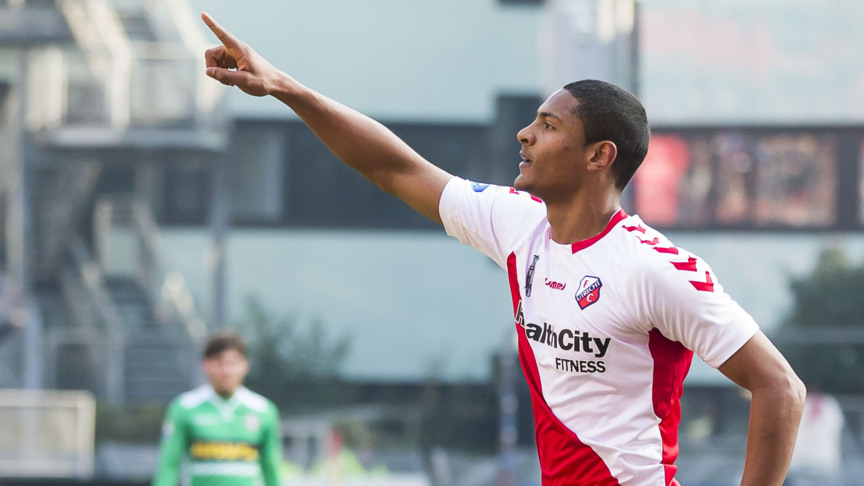A couple of years ago, I used to produce regular mailbags, where I answer reader questions about whatever seems interesting to them. Today we're going to do that again. Despite the fact that this is being published on April Fool's Day, I'm not going to post any idiotic jokes, pranks, or lies herein. These are all actual questions from actual readers and actual answers from actual mes.
Additionally, since I am not employed by any teams right now, we get to talk about transfers and I get to say whatever the hell I want to, regardless of whose plans it might screw up. I can see the world's recruitment analysts and technical scouts wincing already. This should be fun... Here we go!
Who should Arsenal buy as a CM/DM for next season?
A lot of this has to do with who do you think needs replacing and why. Most people asked for a defensive midfielder, but seemed to want passing range and versatility. That is a tough combination to come by, and I think the rumored Granit Xhaka is rather good. However... if I am buying one central midfielder in Europe right now, it's Naby Keita.
Need a DM? Naby Keita.
Need an 8? Naby Keita.
A 10 that scores, creates, and destroys? Na-bee Kay-tuh. (Last time I did a bit like this, it was about Ivan Rakitic replacing Steven Gerrard before there was even a whisper of Rac-attack moving to Barcelona, so you know I am deadly serious.)
Just 21 years old, he played as an elite defensive midfielder in a pressing system last season.
This season he moved forward into an 8/10 role and has put up outrageous scoring stats while losing very little defensive output. No one does that. Only 1.72m tall, Naby is both fast and strong and has excellent balance. He's an outstanding dribbler. He's honestly one of the most athletic young central midfielders I have ever scouted.
The only question is whether his touch passing fits in with Arsenal's style well enough for Wenger to pick him. I think Arsenal need more of this type of athleticism in their squad for certain matchups, and this guy is wildly talented. I have been keeping track of him for quite a while now. At my old job, we [hit by electrical shocks]. So yeah, if I have to pick just one guy to fit in midfield for Arsenal, it's probably him.
What Manager Should Chelsea Hire? What Center Forward Should They Recruit?
The answers to this one are really boring and I apologize for that ahead of time, but these are the questions you gave me! I think Conte is an exceptional head coach who created utterly dominant teams in Serie A. The only real question is whether he can get players to buy into his methodology. I have information from very good sources that he is seriously intense. So is Diego Simeone. Those are my top two choices for manager, and I think Conte is far more likely to end up in London next season.
Can either of them win over the players and get the maximum out of them without losing the whole squad like Mourinho did?
As for a center forward, it's hard to see Chelsea improving much on Diego Costa and Bertrand Traore. I think Traore is one of the best young CFs in Europe and just needs some game time to adapt to the Premier League. I guess they could buy back Romelu Lukaku for twice what they sold him for (ouch), but barring that... Oh, and someone else said Chelsea need a new center back. The good news is you already own the guy I would probably recommend for you - Andreas Christensen. The bad news is that he's allegedly on loan to Gladbach for another season after this one.
What Goalkeeper Should Liverpool Buy?
Sorry folks, stats don't work on goalkeepers. Okay, that's not entirely true, but they only sort of work on GKs and I don't quite have enough time to answer this properly in full. Instead I'll just say they should buy Naby Keita for the midfield and that way whomever they do buy to compete with Mignolet next year will probably have less work to do. That's assuming Arsenal and Spurs don't buy him first. And let's be honest, assuming Arsene Wenger is not going to buy a central midfielder in the summer has been a safe bet for a very long time now. He's probably a more natural fit for Liverpool or Spurs than Arsenal anyway.
Who would you pick - Vincent Janssen or Sebastien Haller?
This is like making me choose between my kids. For those who don't follow the Eredivisie, these are two of the top young center forwards in the league. Do you know that Haller was bought by Utrecht on an option from Auxerre last spring for only 800k Euros? And bigger clubs than Utrecht wanted to buy him both last summer and in January and pay him a LOT more money, but he stayed put.
Rumor in the Netherlands is he only has eyes for Ajax right now, but I could see bigger fish with more money testing his desire to stay in Holland. I could also attempt to tell you an awful lot more about Haller and explain why I know a lot more about him, but that would trigger additional electrical shocks and I'm still kind of jittery after the last batch.
Meanwhile Janssen is one of the top scorers in Europe this season. A physical shot monster, I'm not sure about his pace, but he certainly causes huge problems for Dutch defenders. A couple of scouts I trust have also insisted he's the real deal (stats suggested this was likely months ago), and from what I have seen they are probably right. I would say Haller has a bit more potential and creates a few more goals for his teammates, while Janssen is a tremendous goalscorer right now. For me, Haller wins by a whisker, but it's basically too close to call. (And in the end, it all comes down to price and what the player wants to do anyway.)

This is an interesting question, and the real answer is that no one actually knows. I suspect Arsenal are probably furthest along in football research and they should be, as StatDNA had the biggest head start (outside of the Bolton group that dissipated). I have met a number of Arsenal's top level people on the analysis side and they are wicked smaht. It is annoying when your favorite team is also the team that would need your skill set the least, but thems the breaks. Liverpool are somewhere in the "we develop new football research/tech" sphere.
They even have a Director of Research, so something must be happening there! That's pretty much all I know. Southampton and Spurs probably have some cool stuff going, but I don't know enough about either place to say what. City is really hard to tell what is getting generated and what gets used, but they do have some personnel working on it. I don't think Chelsea or United have been developing anything on the analytics side for some time. Leicester City are doing smart things, but how much of that is related to stats research versus how much is just nailing normal decisions is something I am on the fence about.
But... and this is important... I could be totally fucking wrong.
All this stuff is supposed to be secret. If you are developing edges inside a club, you should NOT be talking about it. That makes it a whole lot of guess work on my part to say who is doing what well. I know we had some things at Smartodds that I was very happy with, and that I am pretty sure are bleeding edge tech (not just cool visualizations), but I can't be totally certain no one else developed those ages ago and simply didn't talk about it.
Our research was developed with a little over a year of full-time access to the Opta database and about two man years worth of output. *light bulb switches on* Funnily enough, I no longer work inside a club, so if Chelsea or Manchester United wanted to find someone smart who COULD talk about cutting edge research and what it could do for them... *makes the "call me" motion* The reason why I am talking about what clubs may or may not have developed is because that's the baseline for state of the art. Some things public analysts have going for them are as follows:
- You can collaborate and make each other smarter. Clubs can't do that except by hiring people from the outside, and they can never do that in scale. I'm not sure if you guys are the vehicle Voltron or the lion one, but you can certainly join together and fight space dragons and shit.
- There are lots and lots and lots of you. Teams have a comparatively tiny number of analysts and most of their brain is likely occupied by day-to-day tasks like how to beat Alan Pardew.
- Many of you have fascinating and unique skill sets to bring to bear on any number of football-related problems.
And some things that public analysts have going against them are as follows:
- Poor access to data and what you have is probably poorly organized unless you are a data/code pimp. If you are a data/code pimp, then you probably spent a lot of time getting your data organized and not doing any analysis or coding new tools or having any fun or...
- Everyone is learning from scratch in most cases and there is no clear path to accelerate that. Those who might create such paths are disincentivized to do so. Constantly recreating the wheel is costly when it comes to edumacation.
- Almost no one does this full-time. Or even half-time. It limits depth of expertise in the subject matter.
- No one has access to all the cool tools you can build which really can accelerate knowledge growth.
- Some of these club analysts have access to sweet proprietary data that only exist inside those clubs! The bastards.
- Top clubs have big budgets that they could spend on this if they saw the value. *again with the "call me" motion (mixedknuts@gmail.com)*
Seriously, if I couldn't walk into any non-Arsenal, non-Liverpool club at this point and introduce them to a single competitive edge that could get them a minimum of 3 extra points a season (which equate to millions of pounds in revenue depending one where a team ends up in the table), I would hang up my analysis boots right now. The advantage left on the table OUTSIDE OF RECRUITMENT is fuck-ing massive at nearly every football club in existence. (Says the person who was just made redundant by a football club. Well, two of them, actually.)
AHEM.
I know it sounds incredibly arrogant or mildly insane that someone who no longer works at a Championship football club believes these Champions League clubs are missing out on enormous competitive edges, but that's exactly what I am saying. My work and reputation at this point is pretty solid, right? You guys trust me not to bullshit you at least a little bit? So you understand there is no way I would insist this to be the case unless I absolutely believed it to be true, and could damn well prove my case in private to people who wanted to listen.
I don't know everything. Hell, I barely know anything. As a whole, we know the tiniest bit about how football works. But that's the thing about sports - it's not about knowing everything, it's about understanding more than your competition. The thing is, once you start looking at these competitive edge problems with the right perspective, you notice improvements all over the place just waiting to be exploited. I dunno man... I assume the guys who figured out on base + slugging percentage were shocked no one else was exploiting it. So did the ones who developed the 3-pointers and drives offense in the NBA.
As did the guys who developed the spread offense in American Football, and countless other sport innovators. Hell, this is the epitome of Bill James' early and middle career. That's kind of where I'm at about all this stuff right now. (No, I did not compare myself to Bill James. He's a legend and I'm just barely getting started. I'm just saying he had an awful lot of knowledge that no one inside the sport really paid attention to for way too long a period of time.)
And the funny thing is, [SO MUCH REDACTED ELECTRICAL SHOCK TREATMENT]. Manchester United copying a single set piece (badly) is the tip o' the fucking iceberg, my friends. Back to the question at hand, I think certain public analysts are creating new things or at least derivative work that is really interesting. So some research might be state of the art. I am definitely not one of those people who think everything has been done already with event data.
In fact, I think we've barely scratched the surface of possibilities there, and I say this as someone who has done an awful lot of scratching. Of course, whenever a public person introduces new material, there's a chance it gets absorbed into the club IP sphere without so much as a thank you, but most people seem to do it as a-fun-hobby-that-could-eventually- some-day-in-the-far-distant-future-possibly-lead-to-a-job-that-doesn't-totally-suck? Do this stuff for yourself.
Make sure you are having fun with it, or go do something else with your free time. And if something happens, great, but don't wait by the phone for that girl to call because there are no girls who actually work in European football. Well, except Sarah Rudd, who happens to be one of the top people in the world in this area.
So if you are a girl, there is still hope that you can also be totally awesome and work in football! And then there would be two of you... Or three, I guess, if we count Marina Granovaskaia at Chelsea. Who I have not met but by all reports is also awesome. But I digress! (And I am clearly going to get in trouble with this, so it's probably time to move on and cut my losses.)
Two quick throughts before I answer other questions. I have run across multiple club owners and directors of football in the last year who have no idea what an expected goal is. Or a shots model. Or almost anything else to do with football stats and data. And these were definitely smart people I was talking to. I mention this not because I was surprised, but to detail a tiny piece of knowledge that people who are in the analytics community take for granted, but which has almost zero penetration beyond this particular football niche.
You don't need to know about expected goals to succeed in football. It helps. When applied correctly, it can definitely allow you to make smarter decisions. But the fact that Arsene Wenger mentioned it once in a press conference and you once-in-a-very-rare-while see it appear in mainstream media does not mean the concept has disseminated among the masses, either in fandom or by those employed in football.
This also relates back to why I think first mover advantage still exists and is enormous. The second anecdote goes back to this excerpt from "The Arm" by Jeff Passan that appeared on Yahoo Sports earlier in the week. That part of the book is awesome and you should read it. Kyle Boddy is the guy developing high velocity pitchers that gets profiled in that piece, and he's been a friend of mine for over a decade now. We've been grumpy old men on the internet together since well before either of us were of an age to be considered old.
We have always been grumpy. Anyway, he's a genius, but this isn't about him, it's about this bit further down.
"The Dodgers were run by Andrew Friedman, the hyperintelligent president of baseball operations who had just left the Rays after a decade-long run of success. In Los Angeles, no budget bound Friedman. The Dodgers had just started an $8 billion local-television contract that allowed their annual payrolls to threaten $300 million. Even better, Friedman and general manager Farhan Zaidi were allowing Fearing to build baseball’s biggest, best think tank. They were seeking experts in quantitative psychology and applied mathematics."
That's where baseball is right now. The only way to win more consistently is to be smarter, even when you have one of the biggest budgets in the league. And yet the excerpt from Passan's book goes a very long way detailing how backwards and wrong baseball have been about development of pitchers for the last decade (and longer). So much of the accepted conventional wisdom was completely and utterly incorrect regarding the most valuable position in the game. Now think about football, which is arguably twenty years behind where baseball is right now.
How much advantage is there for a club who sees a glimpse of the future, has the brain trust and money in place to invest in finding smarter ways to do things, and has the decision making structure to exploit the new intelligence that is discovered? In no other sport in the world do clubs control so many elements they can use to create advantages. Football clubs have access to academy players when they are children.
In the United States, they almost never get access until they are 18 or older. Football clubs also have the potential to completely revamp their roster on a yearly basis if they want to. None of the U.S. sports can do that. Also unique is the worldwide access to talent via the transfer market, and the fact that more people in the world play football than any other sport. Advantageous styles of play. Tactical edges. Better players, for cheaper prices.
Better coaches. Better, different training.
The potential for discovering and leveraging marginal gains for performance improvements is astounding, and this is not pie in the sky stuff. These are things that have been delivered successfully time and again as other sports grew into their analytical ages. But like my wish for a media provider that sees the value in people flocking to their site to generate radars and shot maps on the daily, this vision of what's possible in football is nothing more than a dream that you hope someone with power or influence or money eventually turns into a reality.
That is a project I would like to be a part of. Moving on!
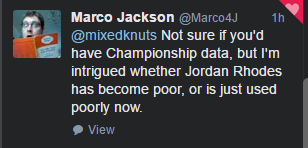
You know how everyone always says that the real strength of using data in sports is to help teams avoid making stupid mistakes? Someone introduce Boro to the concept. Don't get me wrong, they have a great head coach - the hardest position to recruit - and they are lurking right at the top of the Championship again.
That said, their value for money in the transfer market this season has been poor, and the wages they pay out... woof.
It's weird for me to say this, as I have written publicly about Rhodes being a very interesting and sometimes undervalued striker in the past. The reason my tone has changed is because his data changed. After being one of the best forwards in the Football League for almost half a decade, he's now posting below average numbers.
This is a big red flag, especially when it comes to forwards, and double especially when it involves a monster £9M fee plus add-ons plus wages. It's too early to say this is a mistake, but there is an enormous amount of risk attached to it. Risk that Boro will happily deal with and/or write off, should they finally make the promised land of the Premier League.
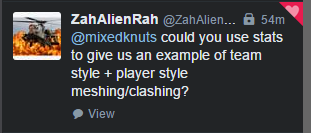
Spurs centerbacks last year was a huge clash. Actually, given they had AVB before, it's weird that Spurs still had CBs that were slow and completely incapable of playing a high pressing style even through last season.
They solved that problem really well this summer. There are countless examples you could roll through - from an unsuitable Mario Balotelli trying to fill a Sturridge/Suarez role at Liverpool, to crossing wingers being added to possession teams, to purely defensive fullbacks being added to teams that need dynamic over- and under-laps to unlock teams in the final third.
Recruitment is tricky in the best of circumstances, but it absolutely must start with a clearly defined style of play that you can then fit players into and around. And it needs a coach who can coach that style of play, or your team is likely to end up in real trouble.

I did not.
I did manage to get a picture with it, which ended up being really important to me because in this business it is so easy to forget your successes. I was lucky enough to play a tiny role in a team winning its first league title and making the Europa League knockout stages. Given that I started all this when I was on chemo, the day FCM held their trophy celebration meant a lot to me. I still get goosebumps when I watch the video.
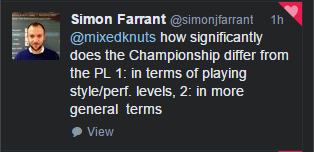
The reffing might be the biggest single difference between the leagues. Lack of called fouls make it a lot harder on skill players, and you definitely focus a bit more at body type when scouting, so that players can have more durability in the Championship.
That said, some fitness guys go too far in having players put on muscle at the expense of actually being able to play football, so there's a balance there. People don't perceive it this way, but there is probably only a small difference in quality of play between the bottom half of the Premier League and the top 6 to 8 teams in the Championship. Plenty of Champ teams now go up and stay there, especially if they have good coaches. Swansea, Southampton, Watford, Bournemouth, and Leicester are all archetypes of clubs that not only go up, but who can perform pretty well once there.
Off the pitch, I think the facilities are tremendously different, especially at the sides who have been established in the Premier League consistently. Then again, most of my time has been spent at one of the lowest revenue clubs in the Championship, so maybe other clubs are way more posh than I expect. The last thing I think is very different is the quality of head coach or manager. The foreign influx in the Premier League, has been enormous, even more than with the players, and as of next season it will be absolutely loaded with top coaches. I think the Championship is still a bit behind that right now, but we are seeing more foreign coach recruitment there as well, so it may not stay that way for long.

True story: I was watching set piece training, and comparing it to what I saw at FC Midtjylland.
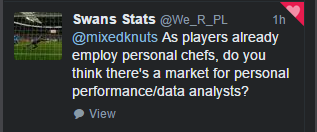
Maybe some day. Here's the thing - you only get so many minutes on a training pitch each week. And yet you have a ton of things you need to teach players about the next opponent, about their own performance, about how they need to develop... about everything. I think at most clubs, the usage of coach analysts is a great way to bridge this gap, from young players through the first team. And at most clubs I don't think this is happening, at all.

Very little, but it does depend a bit on culture/country. I think player capacity for learning is hugely underestimated, especially in England. That said, you need to be really careful with what you introduce and how you introduce it. If I were starting somewhere new, I would do this, but very gently, and I would go out of my way to find out who would likely be receptive ahead of time.

This is funny, because we actually looked at this in detail at work, but it was with Andros Townsend in mind instead of Coutinho. I don't want to ruin it because I still plan to use Townsend in a future presentation and article, but I will say that Coutinho's average shot is about twice as good as Townsend's.
(This assumes that my script isn't horribly bugged, which is not a guarantee right now.) 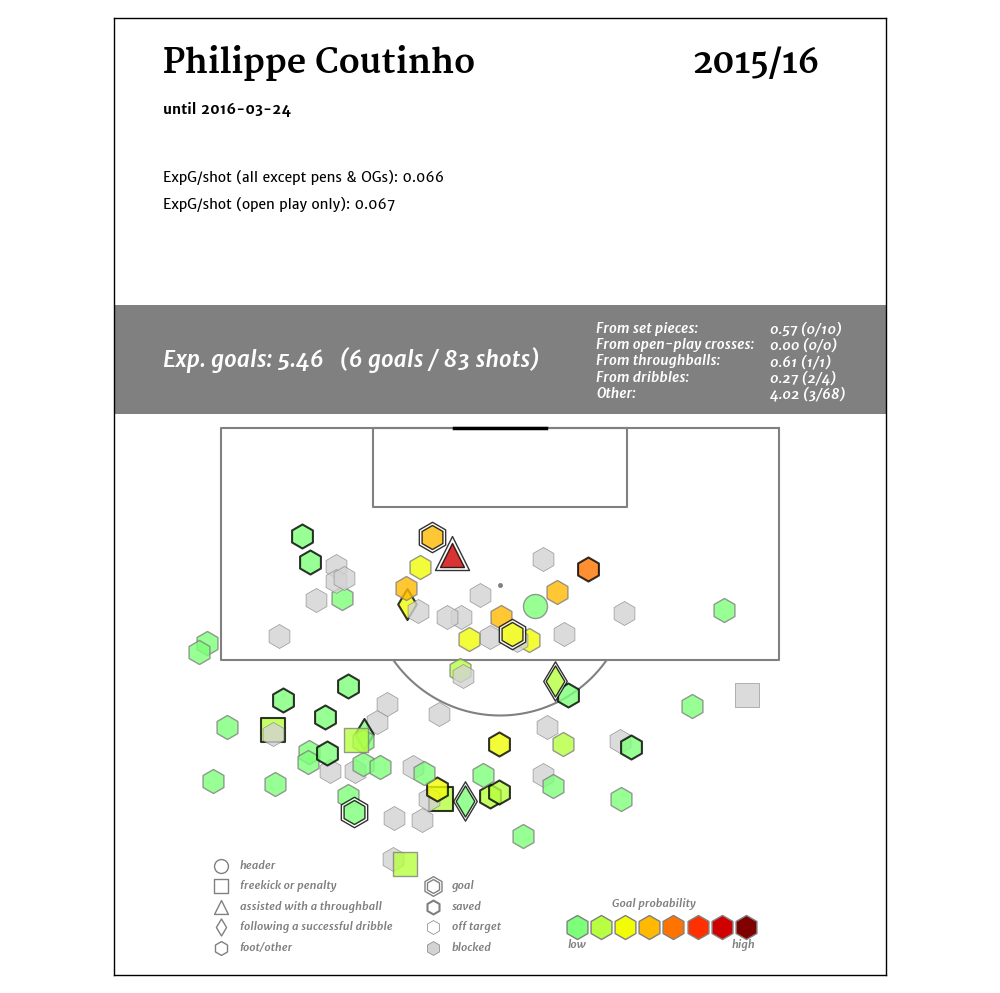
While on this topic, two more fun facts from the Opta data set. First, Bayern's lightning quick wide player Douglas Costa clocks in at around .05 xG per shot average, which is startling for a Pep player and explains the whole two goals in 1700 minutes thing for him. Second, Alessandro Diamanti (briefly of Watford this season) had the worst goal expectation per shot of any high volume guy we looked at back when we were arguing at work. There was one season where his expectation - and I am absolutely not exaggerating this - was about one goal in every 40 to 50 non-penalty shots.
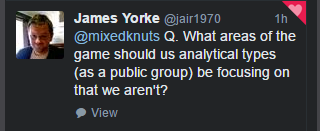
James already knows I am going to say player evaluation and transfers. People love to read it, which in turn means more people will be reading smart data pieces, which HAS to be a good thing, right?
I also think a lot more people should poke around in the same areas that Dustin Ward and Thom Lawrence have been researching (click their names for links to the articles). Their stuff is very smart and as cutting edge as it gets. I'd suggest more people follow in the footsteps of Will Gurpinar-Morgan and Martin Eastwood, but I am pretty sure the education and skills required to do so would be a massive hurdle for just about anybody, myself included.
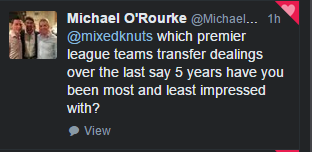
Five years is a long time, and it's hard to stay dumb that long about transfers and stay in the Premier League unless the team is unconscionably rich. I think Arsenal rarely make mistakes in who they buy, so they probably win the award for most impressive.
On the other hand, I think they frequently make mistakes with who they don't buy, or who they sign to new contracts, but those last two things are almost entirely down to Arsene Wenger. I think Chelsea waste a ton of money every year buying confusing players that are highly unlikely to succeed, but they do have some fairly high profile hits as well. They also have a gigantic portfolio of player assets out on loan that could potentially benefit from better management.
Overall though, things aren't that bad there. United have been really poor at signing new players right up until this past season, when they got smart really fast. I think they found a source of good advice in the summer that directed them to good players, even if they seemed to dramatically overpay in almost every instance. It's been really difficult to see a consistent plan at Liverpool.
In fact, from the outside their recruitment has often looked like two rival factions, each getting half the players they wanted and then attempting to assemble a competent squad on the pitch. That seems sub-optimal, but who really knows the truth? If I had to pick one long-term PL club that has shit the bed consistently with regard to transfers over a five-year period, it has to be either Villa or Sunderland. Given the money spent, I'm pretty sure Sunderland win this one by a nose. (And to be fair to them, Villa had so much dead money immediately after the Houllier era, they actually couldn't spend any more and are still digging out of that hole.)
I don't know what happens behind the scenes there, but the recruitment in that place has been horrific for just about as long as I can remember. Finally, if I'm picking a club terrible at recruitment that used to be in the Premier League but isn't any more, it's probably Fulham. From Europa League final in 2010 to 21st in the Championship as of right now. Someone needs to pull the cord there, and soon, or they will follow Wigan and Wolves plunge from the Premier League to League One in no time at all. Nearly 4500 words of blathering, all in response to questions by you.
My wife assures me that I am absolutely, positively going on holiday next week, which means no new content from yours truly on the site. Thankfully, since there is actual football on television this week, James and company will be back and better than ever. Even though I had to lose my job for it to happen, I have really enjoyed being able to write about football again this week, and I hope you have enjoyed reading it.
--TK

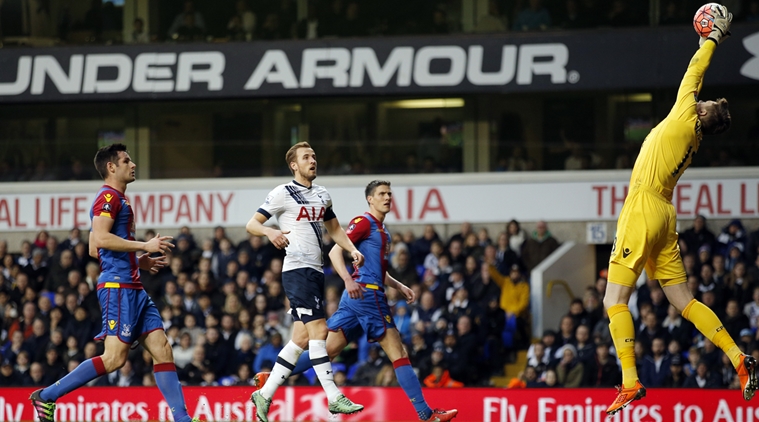 For an upcoming IntoPress piece on the ‘confidence’ trope in football, I decided to have a speculative foray into the numbers, drawing inspiration from the ever controversial ‘hot hand’ debate in basketball. That piece, one for a more general audience and with a wider discussion of the topic, will be available to read in a magazine edition released in May. The polarized debate to which I wade into can be caricatured as something like this – in mainstream analysis, ‘confidence’ is often the explanation for what others may often call variance. If Harry Kane is on a poor run of goal-scoring form, missing a shot is a consequence of a lack of confidence, and vice versa. To the other camp, the one I confess to intuitively belonging in, this is largely unproven nonsense. In the end, what I found wasn’t quite what I expected. Method The data used was event level data for the Premier League, La Liga, Bundesliga, Serie A, Eredivisie, Championship, and Ligue 1, as far back as the 2012/2013 season. I grouped the shots by player and season, before adding two extra rolling variables to each of them – ‘confidence5’ and ‘confidence10’, where:
For an upcoming IntoPress piece on the ‘confidence’ trope in football, I decided to have a speculative foray into the numbers, drawing inspiration from the ever controversial ‘hot hand’ debate in basketball. That piece, one for a more general audience and with a wider discussion of the topic, will be available to read in a magazine edition released in May. The polarized debate to which I wade into can be caricatured as something like this – in mainstream analysis, ‘confidence’ is often the explanation for what others may often call variance. If Harry Kane is on a poor run of goal-scoring form, missing a shot is a consequence of a lack of confidence, and vice versa. To the other camp, the one I confess to intuitively belonging in, this is largely unproven nonsense. In the end, what I found wasn’t quite what I expected. Method The data used was event level data for the Premier League, La Liga, Bundesliga, Serie A, Eredivisie, Championship, and Ligue 1, as far back as the 2012/2013 season. I grouped the shots by player and season, before adding two extra rolling variables to each of them – ‘confidence5’ and ‘confidence10’, where: 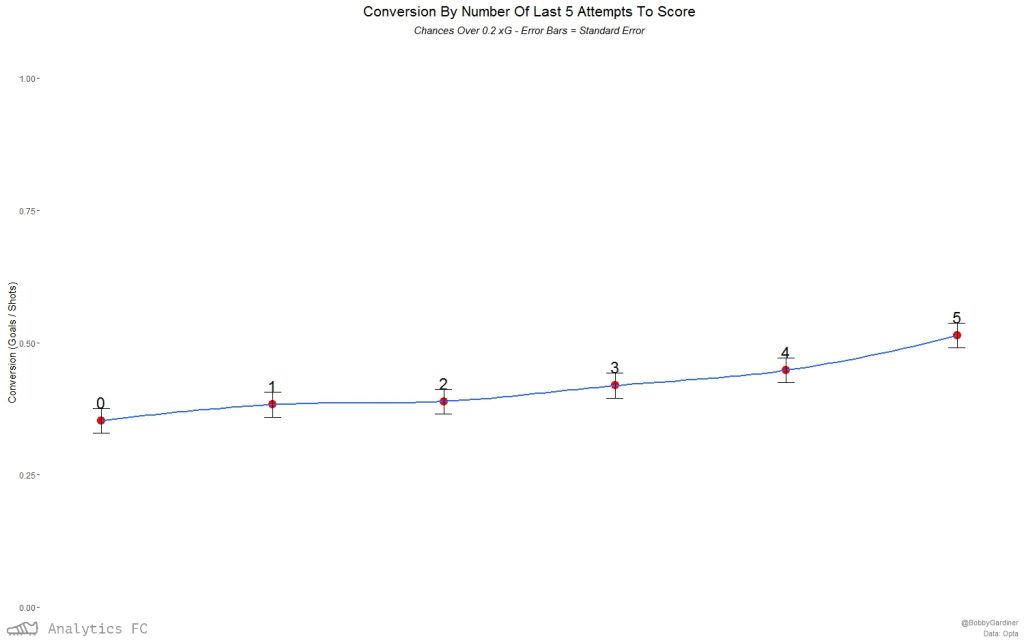 The relationship seems to apply to xG conversion too.
The relationship seems to apply to xG conversion too. 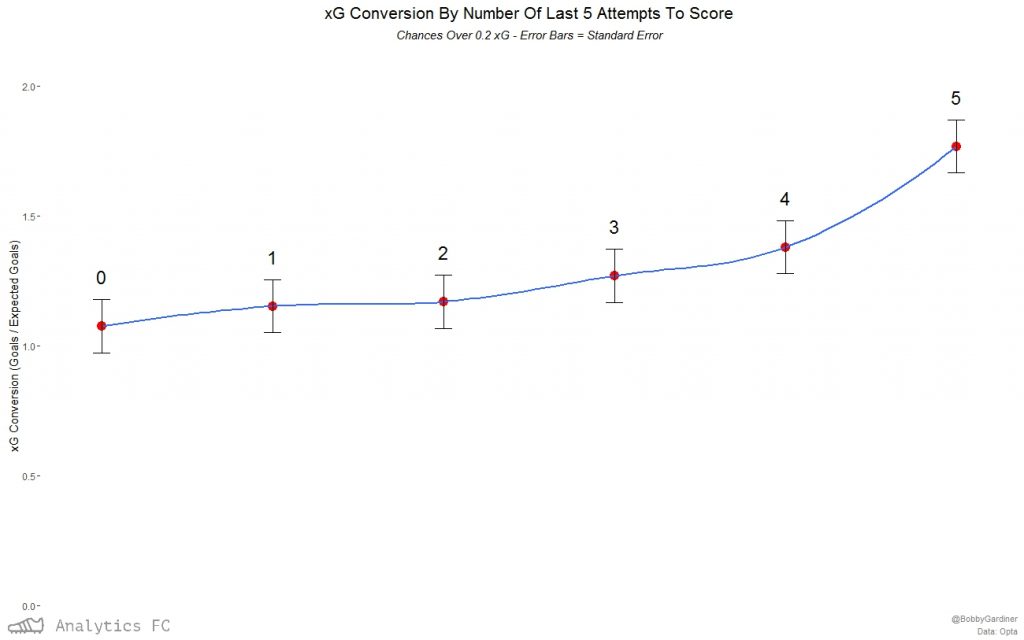 Again, this isn't the case for the control group.
Again, this isn't the case for the control group. 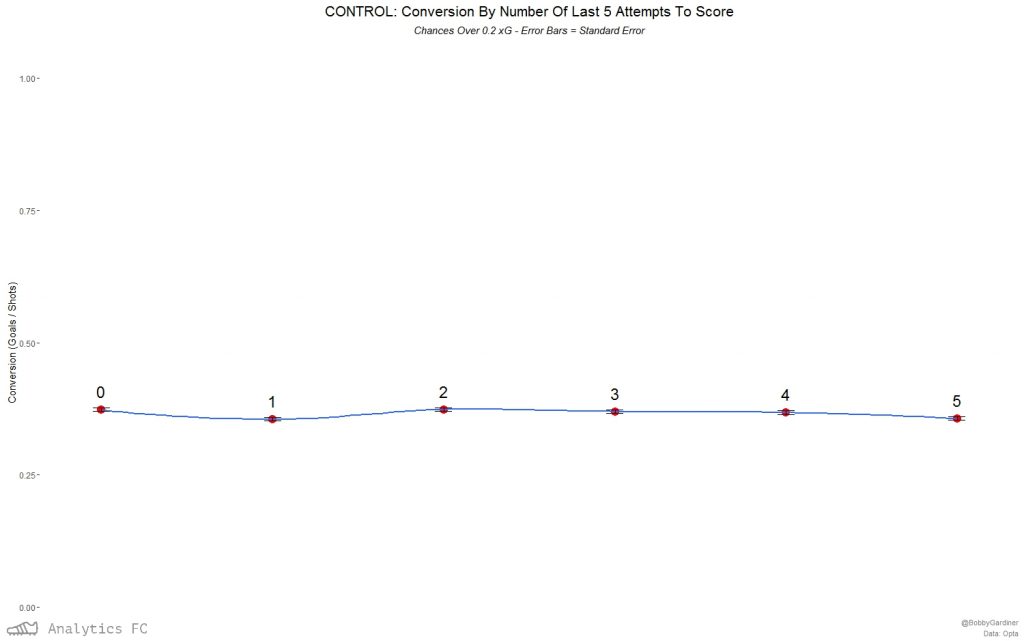 Going back down to the event level data with a logit regression for all chances over 0.2 xG, again the number of the last 5 chances scored was a significant factor in affecting the probability of one of these chances going in. Predicting the probability of success with this model based on ‘confidence5’ alone, I can then plot the relationship with 95% confidence intervals. The model has a McFadden pseudo-r2 of ~ 0.0022 (these tend to be “considerably lower” than OLS r2s in McFadden’s own words), and so is expectedly a small effect.
Going back down to the event level data with a logit regression for all chances over 0.2 xG, again the number of the last 5 chances scored was a significant factor in affecting the probability of one of these chances going in. Predicting the probability of success with this model based on ‘confidence5’ alone, I can then plot the relationship with 95% confidence intervals. The model has a McFadden pseudo-r2 of ~ 0.0022 (these tend to be “considerably lower” than OLS r2s in McFadden’s own words), and so is expectedly a small effect. 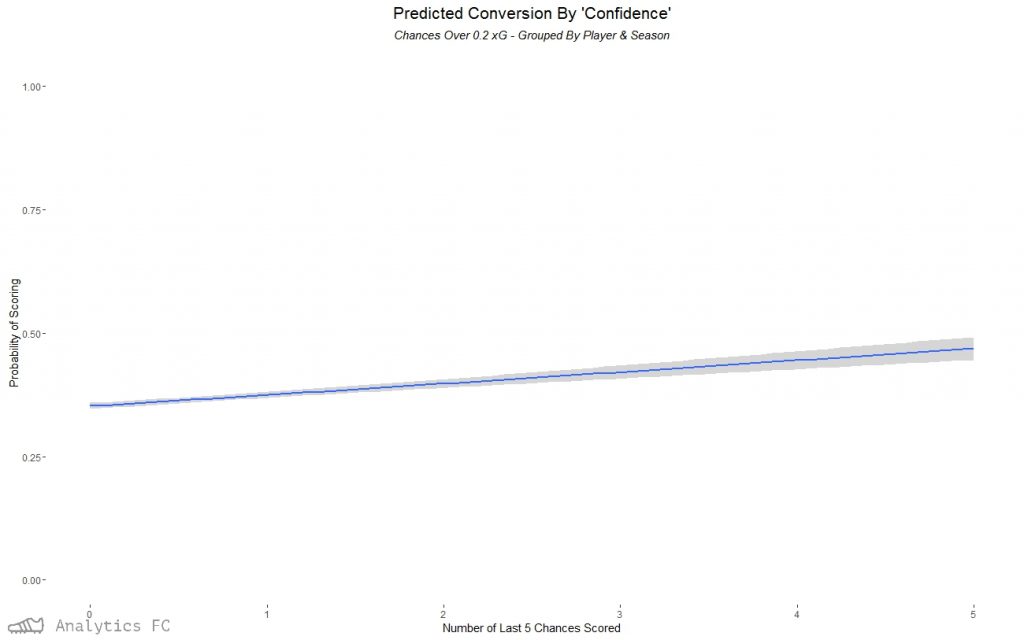
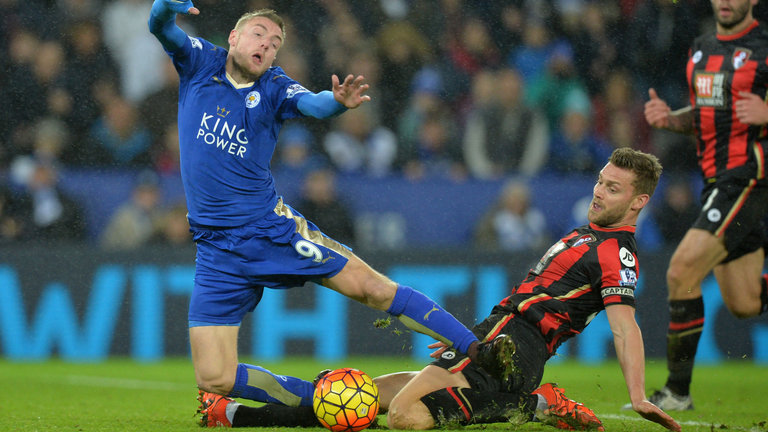
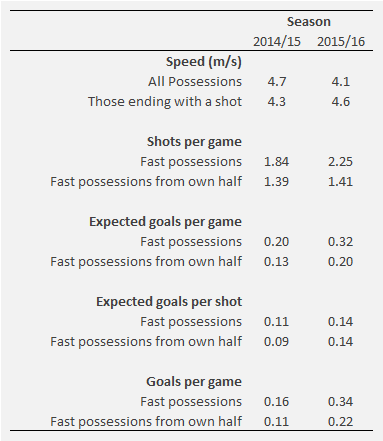

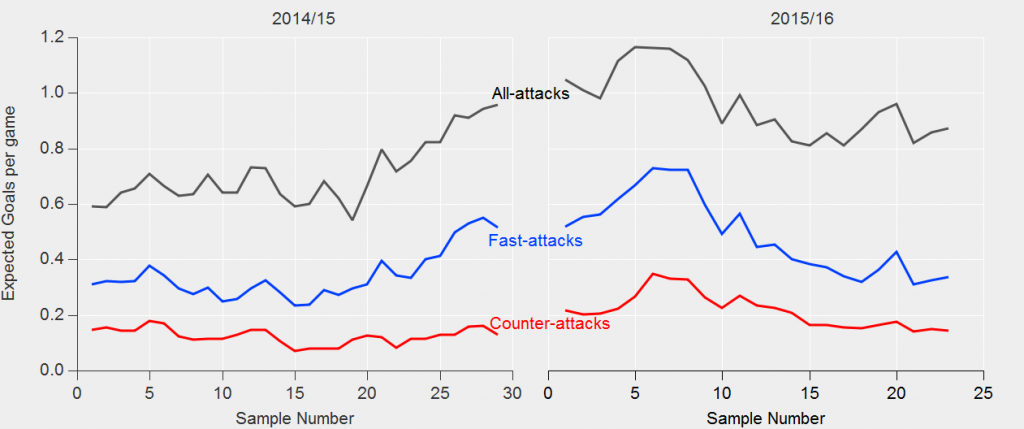
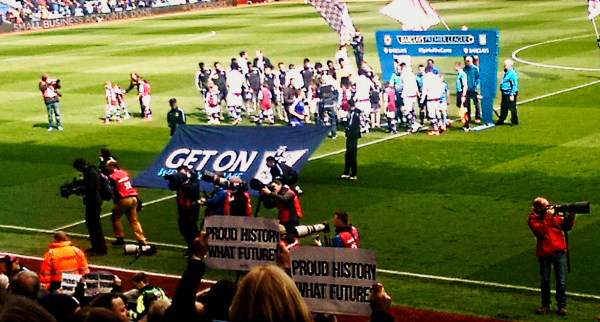
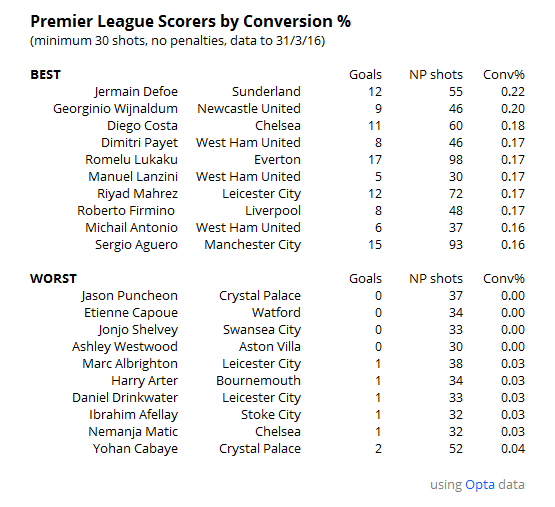
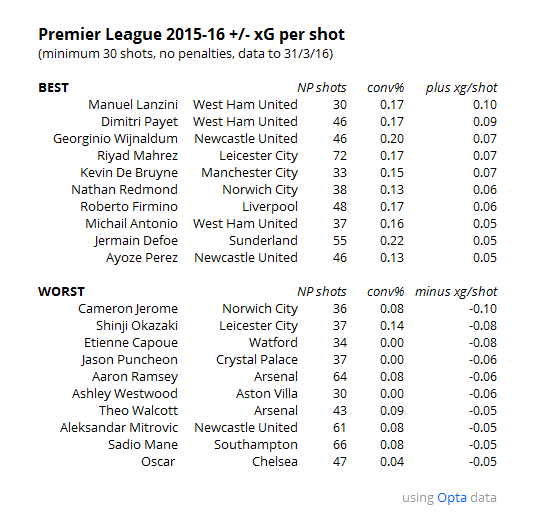
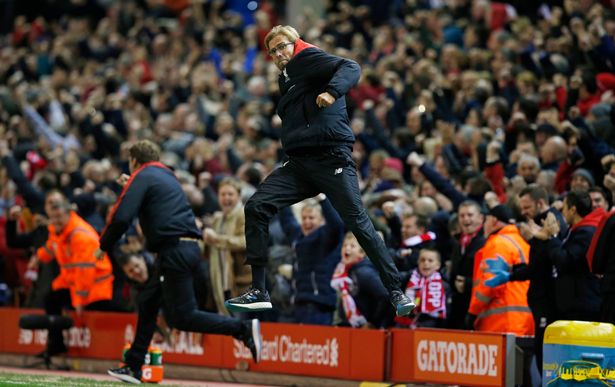
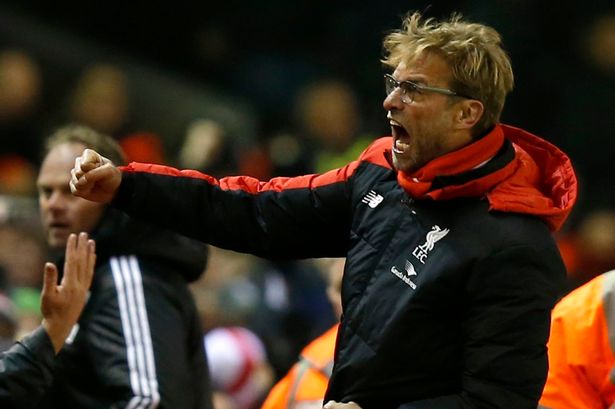 What were they waiting for? Jurgen Klopp was available during the summer and Liverpool gave Brendan Rodgers another shot. Rodgers seems like a solid enough manager but you pounce when you can get Klopp. Liverpool didn't make the same mistake twice and picked up Klopp after 8 games and turned it around to cruise into the Champions League, setting up years of glory...right? Well, maybe it hasn't been smooth so far but even if the first part hasn't gone according to plan, the second and more long-term view is very rosy for the Reds and Klopp is a big reason for it. Let's take a birds-eye view of where Liverpool are now and where they are going. A little context Liverpool are a very good shots team this year, but that's not really new. They've been 2nd in TSR in three of the past five seasons with only 1 top-4 finish in the Real Table*. This year's TSR of .626 is 7th best in all of Europe. The only teams with a better rate are Napoli, Juventus, Dortmund, Bayern, Real Madrid, and Man City. That is special company. Their company when it comes to PDO (basically goal% on both ends) is rather less distinguished. Only Bournemouth, Villa, Udinese, Levante, and Espanyol are worse at turning shots into goals and keeping shots from turning into goals.
What were they waiting for? Jurgen Klopp was available during the summer and Liverpool gave Brendan Rodgers another shot. Rodgers seems like a solid enough manager but you pounce when you can get Klopp. Liverpool didn't make the same mistake twice and picked up Klopp after 8 games and turned it around to cruise into the Champions League, setting up years of glory...right? Well, maybe it hasn't been smooth so far but even if the first part hasn't gone according to plan, the second and more long-term view is very rosy for the Reds and Klopp is a big reason for it. Let's take a birds-eye view of where Liverpool are now and where they are going. A little context Liverpool are a very good shots team this year, but that's not really new. They've been 2nd in TSR in three of the past five seasons with only 1 top-4 finish in the Real Table*. This year's TSR of .626 is 7th best in all of Europe. The only teams with a better rate are Napoli, Juventus, Dortmund, Bayern, Real Madrid, and Man City. That is special company. Their company when it comes to PDO (basically goal% on both ends) is rather less distinguished. Only Bournemouth, Villa, Udinese, Levante, and Espanyol are worse at turning shots into goals and keeping shots from turning into goals. 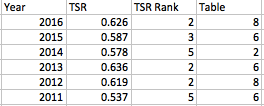 Here's a quick report card on the rest of the big stuff.
Here's a quick report card on the rest of the big stuff.  We very quickly see that Liverpool are performing right where they want to be on the big picture, most-repeatable stuff: holding the ball, pushing the ball into dangerous areas, keeping opponents from getting the ball into dangerous areas, accumulating shots, and preventing shots. In the Klopp-era all of these things shoot up even higher, to basically 2nd best everywhere. Unsurprisingly to those who have followed Liverpool closely, it's at the final step of the process that the Liverpool machine breaks down. It's business class from NYC to Dallas, and then Greyhound bus to El Paso. And yes, your seat-mate is smoking, does it bother you? The poor shot quality for and against helps explain their horrendous conversion rates and the 9th place standing. So what are Liverpool? Does the PDO represent a team who has no shot discipline and glaring weaknesses in defense or does that shot rate indicate this team is very close to becoming one a juggernaut? Let's find out. Field Control
We very quickly see that Liverpool are performing right where they want to be on the big picture, most-repeatable stuff: holding the ball, pushing the ball into dangerous areas, keeping opponents from getting the ball into dangerous areas, accumulating shots, and preventing shots. In the Klopp-era all of these things shoot up even higher, to basically 2nd best everywhere. Unsurprisingly to those who have followed Liverpool closely, it's at the final step of the process that the Liverpool machine breaks down. It's business class from NYC to Dallas, and then Greyhound bus to El Paso. And yes, your seat-mate is smoking, does it bother you? The poor shot quality for and against helps explain their horrendous conversion rates and the 9th place standing. So what are Liverpool? Does the PDO represent a team who has no shot discipline and glaring weaknesses in defense or does that shot rate indicate this team is very close to becoming one a juggernaut? Let's find out. Field Control 
 but the "very direct" category is not abnormal at all so they aren't being torn apart. If they were being repeatedly shredded and caught upfield you'd expect the defense to break down in front of goal. We don't see this at all. We see the opposite. No team has held opponents to a lower danger zone completion percentage than the Reds: 33.3%. So under Klopp Liverpool have managed to have a team that can press high effectively, keep teams from reaching the danger zone at an elite level and be the toughest to actually complete a pass in the danger zone against. Only Tottenham have anything like that all over the field and they can't match up when it comes to keeping opponents away from the danger zone.
but the "very direct" category is not abnormal at all so they aren't being torn apart. If they were being repeatedly shredded and caught upfield you'd expect the defense to break down in front of goal. We don't see this at all. We see the opposite. No team has held opponents to a lower danger zone completion percentage than the Reds: 33.3%. So under Klopp Liverpool have managed to have a team that can press high effectively, keep teams from reaching the danger zone at an elite level and be the toughest to actually complete a pass in the danger zone against. Only Tottenham have anything like that all over the field and they can't match up when it comes to keeping opponents away from the danger zone. 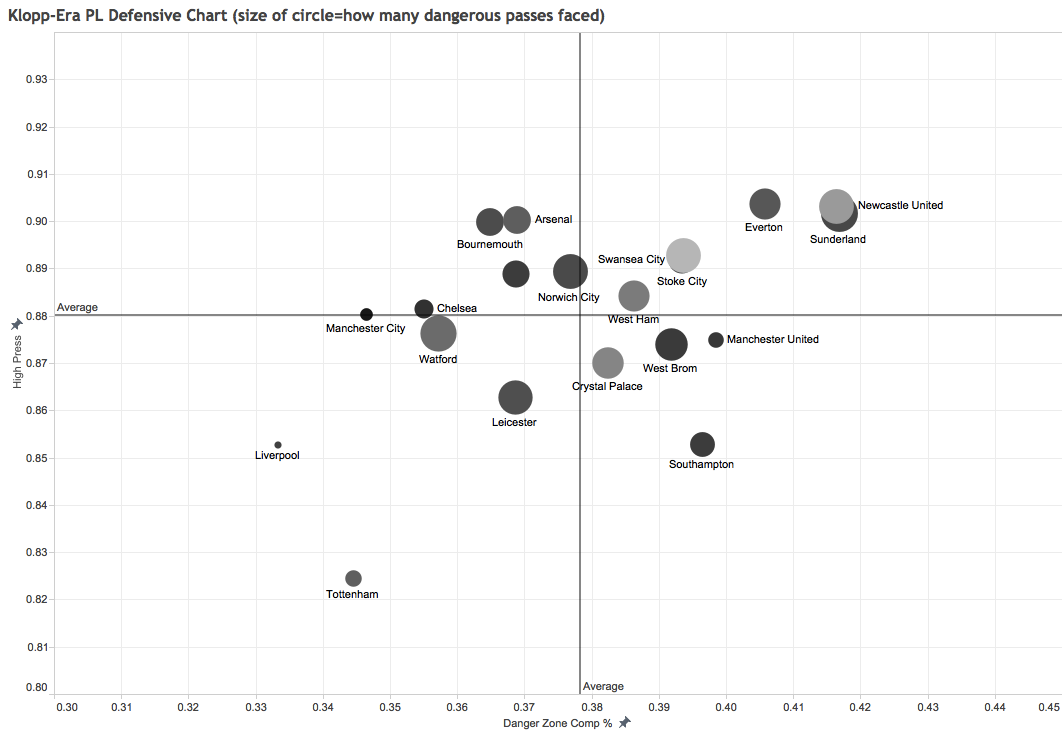
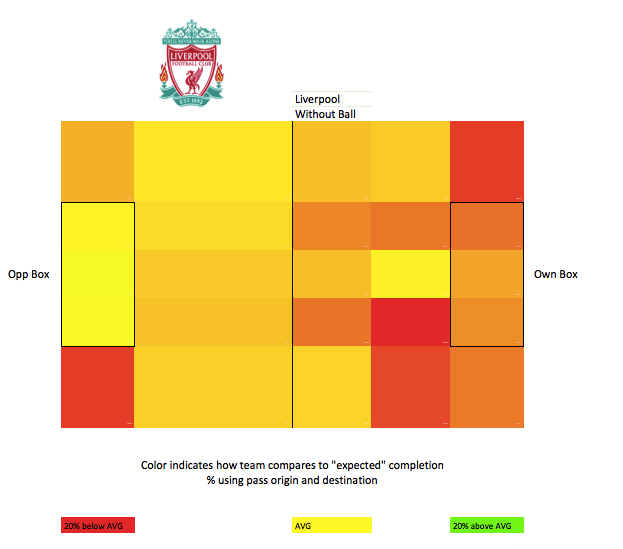
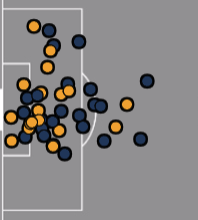
 Liverpool SOT allowed from November-January using Paul Riley's
Liverpool SOT allowed from November-January using Paul Riley's 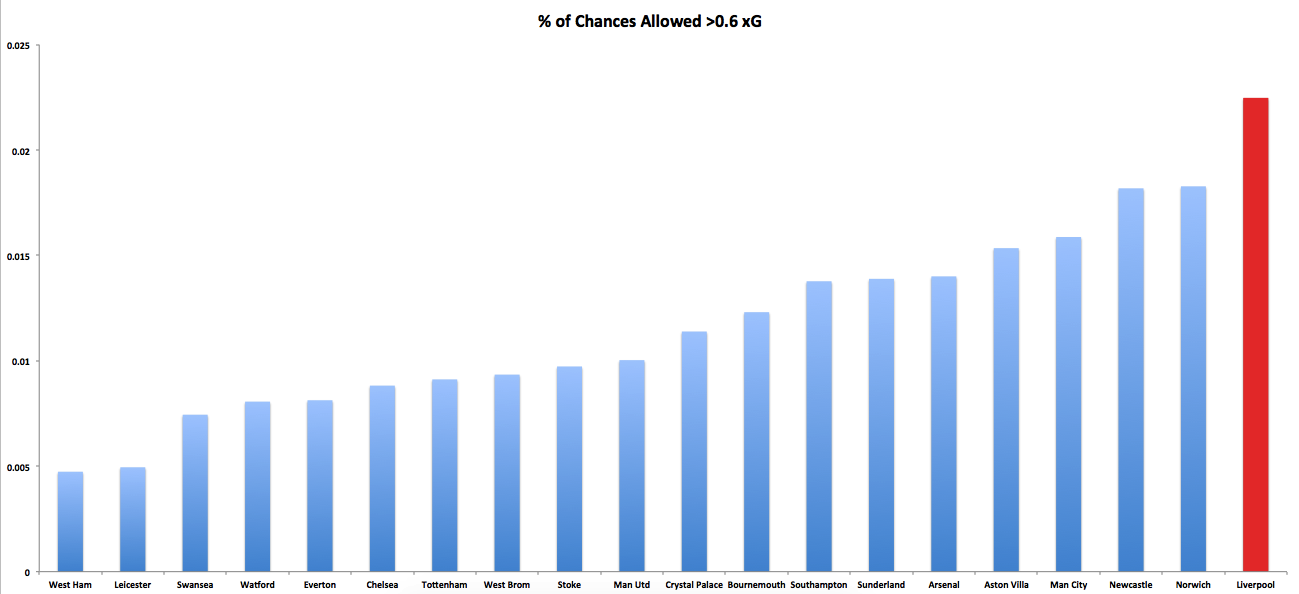
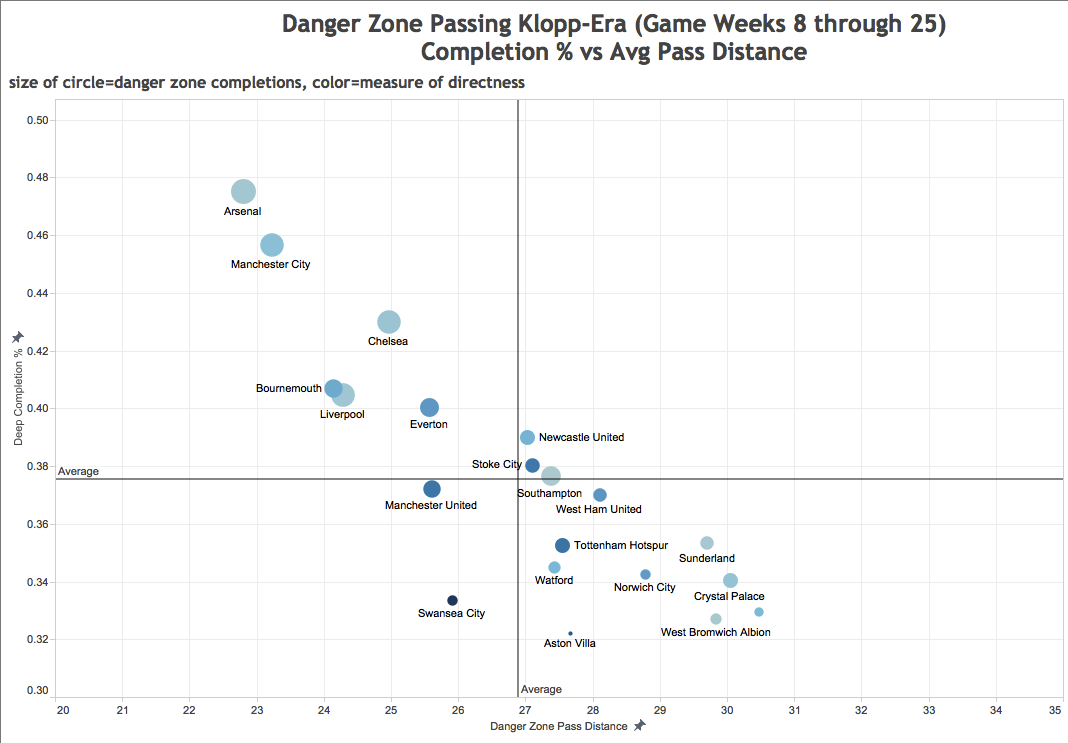
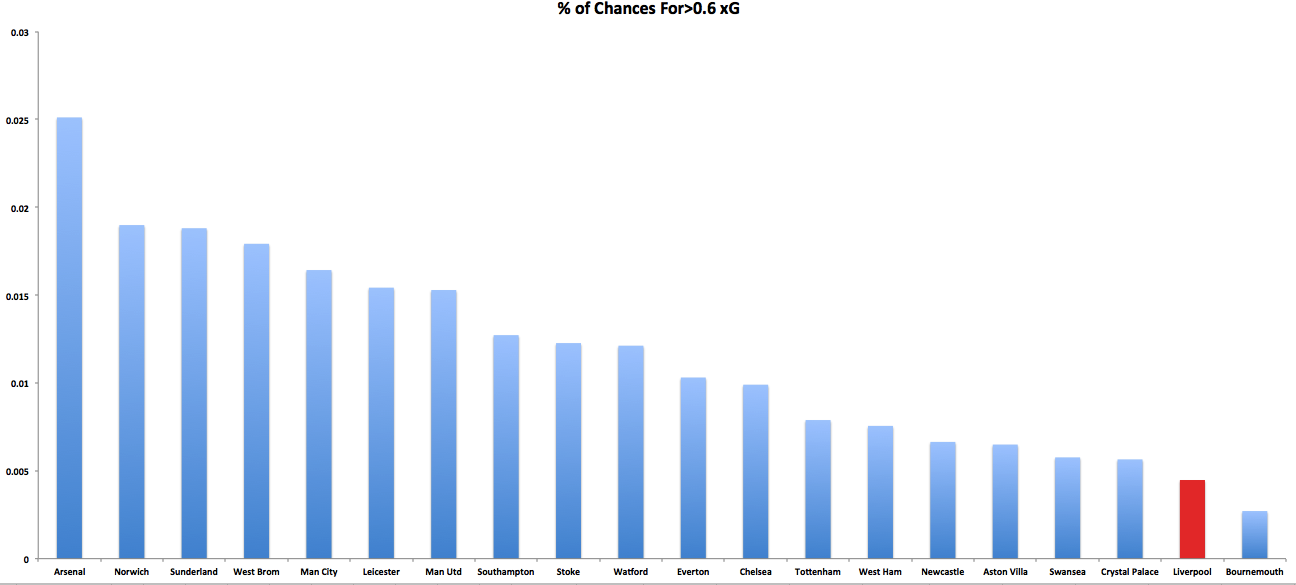
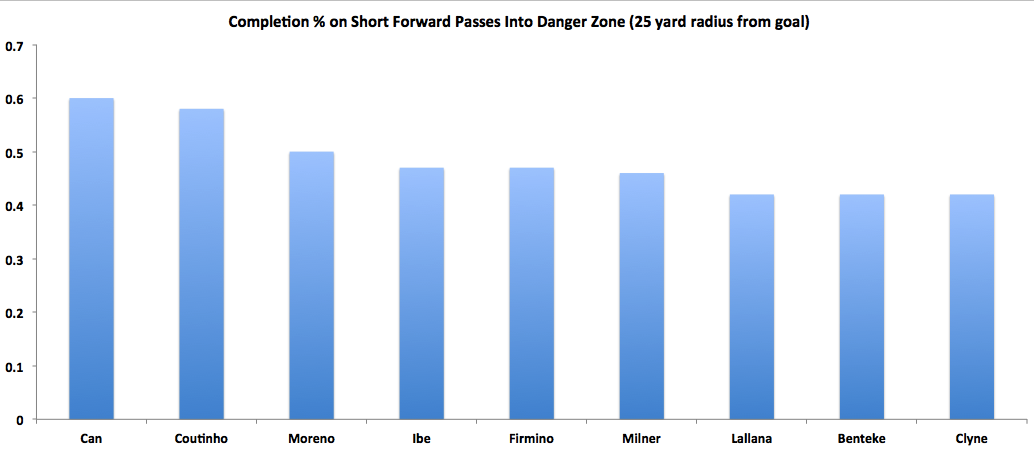
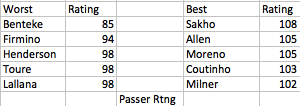
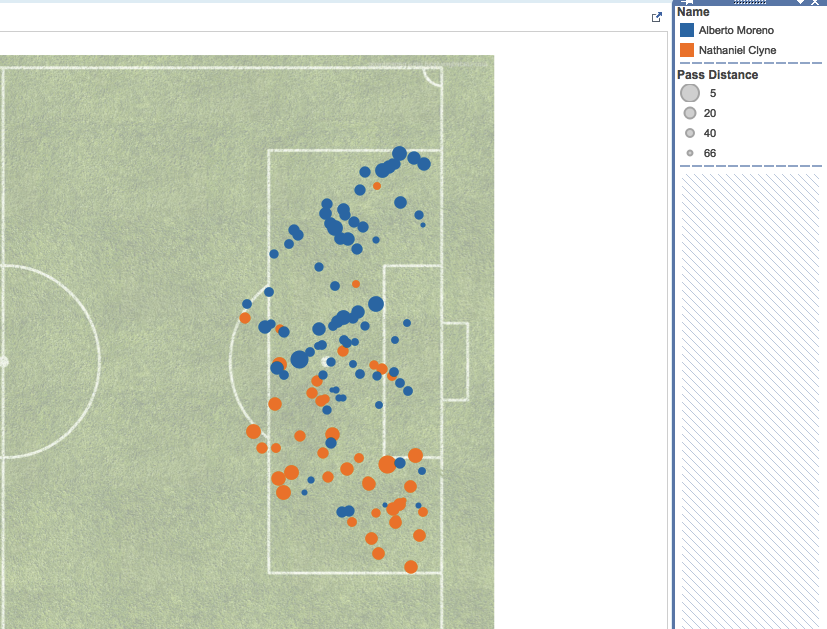
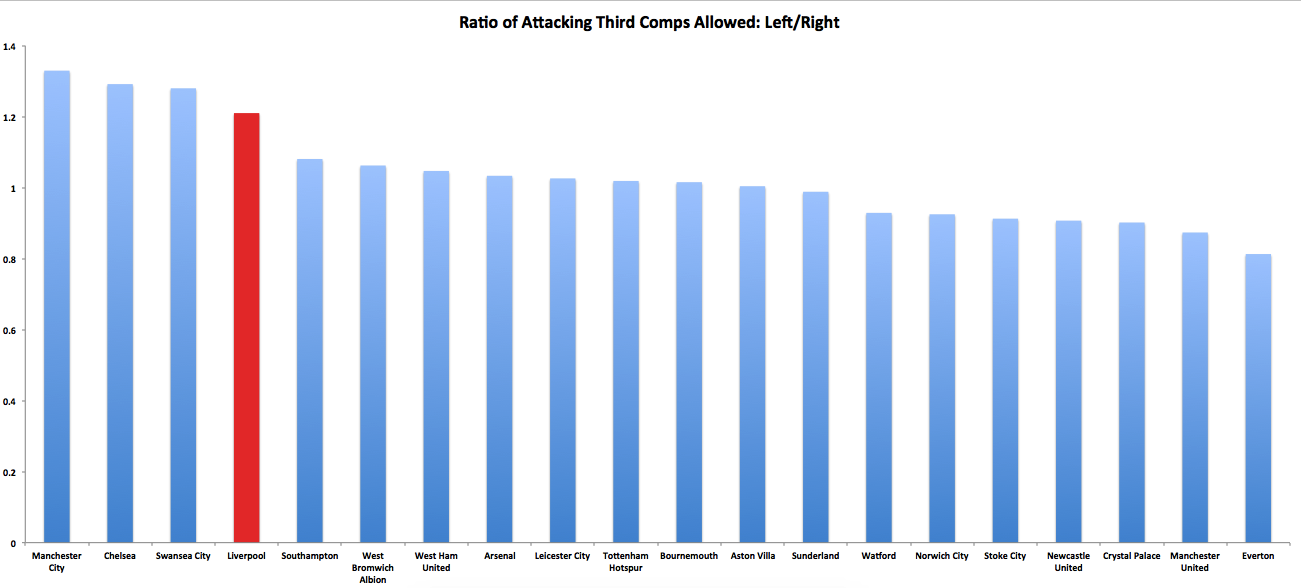
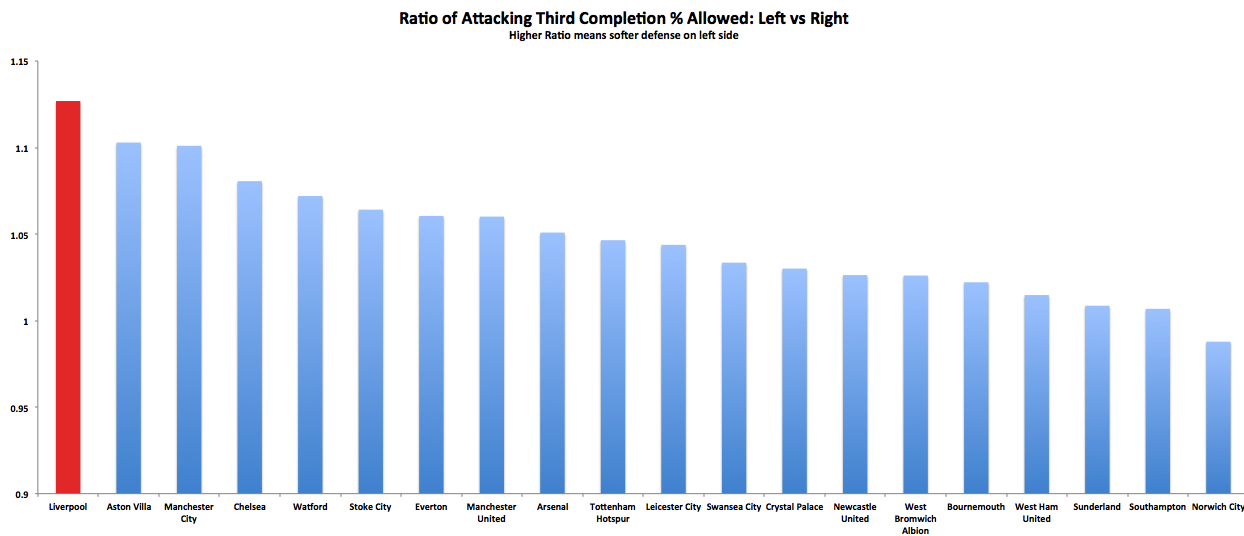 Those are some seriously unbalanced fullbacks. Why can't we combine the two?
Those are some seriously unbalanced fullbacks. Why can't we combine the two?  Sakho remains one of the best center backs at advancing the ball in the league. I love Kolo Toure but his body is failing him and at this point he's probably not even a top-end Championship player. Offseason shopping list: 1. keeper, 2. athletic midfielder, Lucas doesn't have the legs to stay there much longer. Conclusion Liverpool are in as good a long-term situation as they've been in recent history. They dominate the ball and tilt the field in a way that only Man City and Arsenal can match. This years weaknesses have come down to shot quality which has been heavily influenced by shocking and unlucky proportions of top-tier chances allowed and taken. These will likely even out a good bit without anything changing but the underlying causes there are those that have the easiest fixes: a new goalie, a new centerback and a healthy Sturridge and Coutinho. Without the ball, only Tottenham can claim to play nearly as well as the Klopp's squad. If Daniel Sturridge can remain healthy, there is no more complete team heading into next season than Liverpool. Man City and Arsenal's attacking firepower will make them slight favorites but Liverpool should expect to be the 3rd best team within touching distance of the top starting today and going into next season. Liverpool have the coach and the fundamentals and are right at the edge, the next step isn't a hard one to make.
Sakho remains one of the best center backs at advancing the ball in the league. I love Kolo Toure but his body is failing him and at this point he's probably not even a top-end Championship player. Offseason shopping list: 1. keeper, 2. athletic midfielder, Lucas doesn't have the legs to stay there much longer. Conclusion Liverpool are in as good a long-term situation as they've been in recent history. They dominate the ball and tilt the field in a way that only Man City and Arsenal can match. This years weaknesses have come down to shot quality which has been heavily influenced by shocking and unlucky proportions of top-tier chances allowed and taken. These will likely even out a good bit without anything changing but the underlying causes there are those that have the easiest fixes: a new goalie, a new centerback and a healthy Sturridge and Coutinho. Without the ball, only Tottenham can claim to play nearly as well as the Klopp's squad. If Daniel Sturridge can remain healthy, there is no more complete team heading into next season than Liverpool. Man City and Arsenal's attacking firepower will make them slight favorites but Liverpool should expect to be the 3rd best team within touching distance of the top starting today and going into next season. Liverpool have the coach and the fundamentals and are right at the edge, the next step isn't a hard one to make.